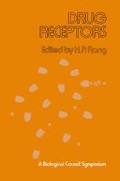Abstract
At a previous symposium on drug action, entitled Adrenergic Mechanisms, the dual action of adrenaline was one of the problems discussed. The observations then available led to the idea (Bülbring, 1960) that adrenaline had two actions, one a direct action on the cell membrane and another action affecting the membrane only indirectly, the primary action being metabolic. The direct action on the membrane (α-action)—presumably an increase in permeability to one or several ions—would depolarize the membrane and make it more excitable. The metabolic action (ß-action) on the other hand, would affect the functional state of the cell by making more metabolic energy available. It was assumed that this energy could be used, not only for the contractile mechanism, but also for metabolic processes which stabilize the cell membrane, making it less excitable.
Preview
Unable to display preview. Download preview PDF.
References
Born, G. V. R. (1971). In: Effects of Drugs on Cellular Control Mechanisms, Biological Council Symposium, ed. Rabin, B. R. & Freedman, R. B., p. 237. London: Macmillan.
Brading, A. F.,Bülbring , E. &Tomita , T. (1969a). J. Physiol., Lond., 200, 621.
Brading, A. F.,Bülbring , E. &Tomita , T. (1969b). J. Physiol., Lond., 200, 637.
Bueding, E.,Bülbring , E.,Gercken , G.,Hawkins , J. T. &Kuriyama , H. (1967). J. Physiol., Lond., 193, 187.
Bueding, E.,Butcher , R. W.,Hawkins , J.,Timms , A. R. &Sutherland , E. W. (1966). Biochim. biophys. Acta, 115, 173.
Bülbring, E. (1955). J. Physiol., Lond., 128, 200.
Bülbring, E. (1960). Adrenergic Mechanisms. Ciba Foundation Symposium, p. 275. London: Churchill.
Bülbring, E. (1970). Rendic. R. Gastroenterol., 2, 197.
Bülbring, E.,Brading , A. F.,Jones , A. W. &Tomita , T. (1970). Smooth Muscle. London: Edward Arnold.
Bülbring, E.,Casteels , R. &Kuriyama , H. (1968). Br. J. Pharmac. Chemother., 34, 388.
Bülbring, E. &Kuriyama , H. (1963). J. Physiol., Lond., 166, 29.
Bülbring, E. &Szurszewski , J. H. (1971). J. Physiol., Lond., 217, 39 P.
Bülbring, E. &Tomita , T. (1968). J. Physiol., Land., 194, 74.
Bülbring, E. &Tomita , T. (1969a). Proc. R. Soc., B, 172, 89.
Bülbring, E. &Tomita , T. (1969b). Proc. R. Soc., B, 172, 103.
Bülbring, E. & Tomita, T. (1969c). Proc. R. Soc., B, 172, 121.
Bülbring, E. &Tomita , T. (1970a). J. Physiol., Lond., 210, 217.
Bülbring, E. &Tomita , T. (1970b). In: A Symposium on Calcium and Cellular Function ed. Cuthbert, A. W., p. 249. London: Macmillan.
Casteels, R. (1965). J. Physiol., Lond., 178, 10.
Casteels, R. &Kuriyama , H. (1965). J. Physiol., Lond., 177, 263.
Coutinho, E. M. &Csapo , A. (1959). J. gen. Physiol., 43, 13.
Dale, H. H. (1906). J. Physiol., Lond., 34, 163.
Dale, H. H. (1913). J. Physiol., Lond., 46, 291.
Holman, M. E. (1958). J. Physiol., Lond., 141, 464.
Ito, Y.,Kuriyama , H. &Sakamoto , Y. (1970). J. Physiol., Lond., 211, 445.
Kuriyama, H. (1963). J. Physiol., Lord., 166, 15.
Kuriyama, H.,Osa , T. &Toida , N. (1966). Br. J. Pharmac. Chemother., 27, 366.
Magaribuchi, T.,Ito , Y. &Kuriyama , H. (1971). Jap. J. Physiol., 21, 691.
Mekata, F. &Niu , H. (1972). J. gen. Physiol., 59, 92.
Ohashi, H. (1970). J. Physiol., Lond., 210, 405.
Osa, T. &Kuriyama , H. (1970). Jap. J. Physiol., 20, 626.
Panet, R. &Selinger , Z. (1972). Biochim. biophys. Acta, 255, 34.
Robison, G. A.,Butcher , R. W. &Sutherland , E. W. (1971). Cyclic AMP. New York & London: Academic Press.
Romero, P. J. &Whittam , R. (1971). J. Physiol., Lond., 214, 481.
Shuba, M. F. &Klevets , M. Y. (1967). Sechenov. Physiol. J., USSR, 13, 1.
Szurszewski,J. H. (1971). B.Sc. Thesis, University of Oxford.
Vogt, M. (1965). J. Physiol., Lond., 179, 163.
Wahlström, B. (1972). J. Physiol., Lond., 226, 63P.
Author information
Authors and Affiliations
Editor information
Editors and Affiliations
Copyright information
© 1973 Institute of Biology Endowment Trust Fund
About this chapter
Cite this chapter
Bülbring, E. (1973). Action of Catecholamines on the Smooth Muscle Cell Membrane. In: Rang, H.P. (eds) Drug Receptors. Biological Council. Palgrave, London. https://doi.org/10.1007/978-1-349-00910-7_1
Download citation
DOI: https://doi.org/10.1007/978-1-349-00910-7_1
Publisher Name: Palgrave, London
Print ISBN: 978-1-349-00912-1
Online ISBN: 978-1-349-00910-7
eBook Packages: Biomedical and Life SciencesBiomedical and Life Sciences (R0)

